Giant rhubarb (Gunnera tinctoria) identification
What is Gunnera? Read through our Gunnera identification guide below. If you are still unsure, email us your photos and we will confirm whether it is Giant rhubarb for FREE
With leaves that grow to 2 metres in diameter, the Gunnera plant or Giant rhubarb is increasingly becoming a nuisance in the UK, especially in the southwest of England. It thrives in damp habitats and can quickly overwhelm other plants causing damage to local ecosystems
Quick facts
- Gunnera tinctoria is more commonly known as giant or Chilean rhubarb.
- It prefers damp conditions such as riverbanks, boggy areas, and garden ponds.
- Its large leaves are easy to spot, and the plant can grow to heights of 2m.
- It is illegal to allow Gunnera tinctoria to grow or spread in the wild outside the confines of your property or garden.
Quick Links




What is Gunnera?
Gunnera is a genus of large, herbaceous flowering plants, known for their enormous leaves. Native to tropical and temperate regions, these plants are mainly native to the South Americas. The genus contains about 40–60 species, with some of the most famous species being Gunnera manicata and Gunnera tinctoria.
Here are some key points about Gunnera:
Size and Leaves: Gunnera is renowned for its gigantic leaves, with some species having leaves that can grow up to 3 meters (10 feet) in diameter. These leaves often have a rough, textured surface and can resemble giant rhubarb (hence the nickname “giant rhubarb,” although it is unrelated to true rhubarb).
Habitat: Gunnera typically thrives in wet, marshy conditions, making it a popular plant for water gardens or damp landscapes.
Root Nodules: Gunnera plants form a symbiotic relationship with cyanobacteria (blue-green algae) in root nodules. These bacteria fix nitrogen from the air, providing nutrients for the plant.
Invasive Species: While Gunnera is admired in gardens, some species, like Gunnera tinctoria, are considered invasive in regions like Ireland and New Zealand due to their rapid spread and ability to outcompete native vegetation.
Gunnera is a striking plant often used for dramatic effect in landscaping but must be managed carefully in areas where it might become invasive.
Is all Gunnera illegal?
Gunnera tinctoria, one of the species of the Gunnera genus, is considered invasive in parts of the UK and is regulated due to its potential to disrupt native ecosystems. While it is not completely illegal to possess or grow, it is subject to restrictions under UK law.
Specifically:
Schedule 9 of the Wildlife and Countryside Act 1981: Gunnera tinctoria is listed under this act in the UK, meaning it is illegal to plant or allow this species to grow in the wild.
Invasive Alien Species (Enforcement and Permitting) Order 2019. Gunnera tinctoria and its hybrids are listed, banning all intentional planting.
These regulations aims to prevent the spread of the plant into natural habitats where it could outcompete native species.
In 2023, research was published on Gunnera manicata (Giant rhubarb) that showed most of the UK population was actually a hybrid of G. manicata & G. tinctoria (named Gunnera x cryptica). The UK government therefore plans to subject all G. manicata plants to the same restrictions.


Why is Gunnera tinctoria a problem?
Gunnera tinctoria is considered a problem in the UK because of its invasive nature and the environmental damage it can cause when it spreads uncontrollably. Here are the key reasons why it’s problematic:
1. Outcompeting Native Species
Gunnera tinctoria has a fast-growing habit and can form dense stands, which block sunlight and outcompete native plants. Its large leaves create a thick canopy that prevents light from reaching smaller plants underneath, suppressing their growth and reducing biodiversity.
2. Altering Habitats
By outcompeting native plants, Gunnera tinctoria can alter the composition of local ecosystems, particularly in wetlands, riverbanks, and other moist environments where it thrives. This can disrupt the balance of the ecosystem, negatively affecting not only plant life but also the animals that depend on native species for food and habitat.
3. Difficult to Control
Once established, Gunnera tinctoria is difficult to remove due to its extensive root system. Even small fragments of the root can regenerate into new plants, making mechanical removal challenging. Its ability to spread quickly through seed dispersal and vegetative growth means that it can rapidly colonise new areas if not controlled effectively.
What does Gunnera tinctoria look like?
Gunnera Flowers
The plant produces red panicles, or cones of small flowers – once these become pollinated, they produce small reddish berries which finally turn into black seeds. The flower spikes start to form around May, and can be a metre in length. The berries and seeds start to form as we head into the Autumn.
Gunnera Stems
The plant has upright, prickly stems that can be quite painful if you pick them up by hand. On young plants these tend to be greenish but as they matures the stems turn a red or purple colour.
Gunnera Leaves
Gunnera has large, umbrella-like leaves that can be up to m wide on mature plants. If you turn over the leaves, tinctoria has trichomes (hairs) on the main leaf nerves and the veins at the base of the leaf are purple.

Gunnera varieties
There are around 63 distinct types of Gunnera around the world, mostly in more southern regions, though this is changing.Gunnera tinctoria, for example, has been found much further north in the last 50 to 60 years, likely a result of climate change. Some species are hardier than others, but they require a lot of water which is why you find them near ponds, rivers and bogland.
You cannot miss most species of Gunnera as they are quite large and imposing. They have leaves that can be as much as 2 metres wide and the whole plant looks like a more gigantic version of our traditional rhubarb.
The Gunnera manicata is still a popular choice in larger gardens where there is a pond or stream nearby, but they are not often found in smaller gardens, unless by accident. People who do have the plant on their property, however, need to make sure that they collect the seeds and don’t allow them to spread.
There are some variations between types of giant rhubarb, notably their size – but the unmistakable jagged-edged leaves, with deep veins sitting on upright, prickly stems are shared by all plants in the family – making them easy to identify.
Gunnera manicata or Brazilian Giant Rhubarb
Again, prevalent in South America, the leaves of the Gunnera manicata look similar but are less ragged and slightly narrower than the Gunnera tinctoria. The stalk is pale green, and the spikes are a reddish hue. The flowering spike is a little more sprawling than its close relative and is wider than it is longer, growing near the ground. The flowers are greenish yellow rather than red or crimson.
Gunnera Megellanica or the Devil’s Strawberry
Not all Gunnera are prehistorically huge and impressive. The Gunnera megallanica can be considered the dwarf version as it only grows a few centimetres tall.
It has kidney-shaped dark green leaves with fine hairs and produces clusters of small red berries that give the plant its more common name, the devil’s strawberry. While not on any lists, Gunnera megellanica can become invasive if not tended to properly.


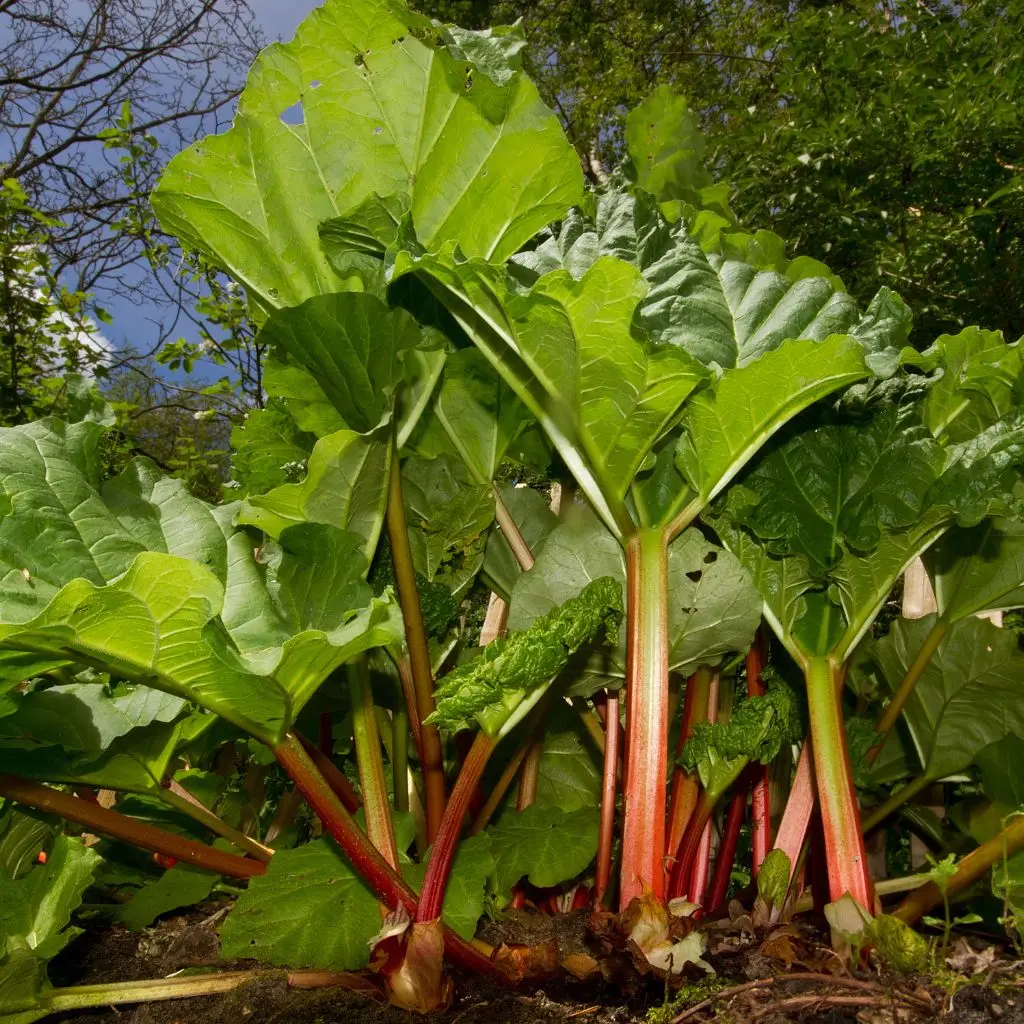
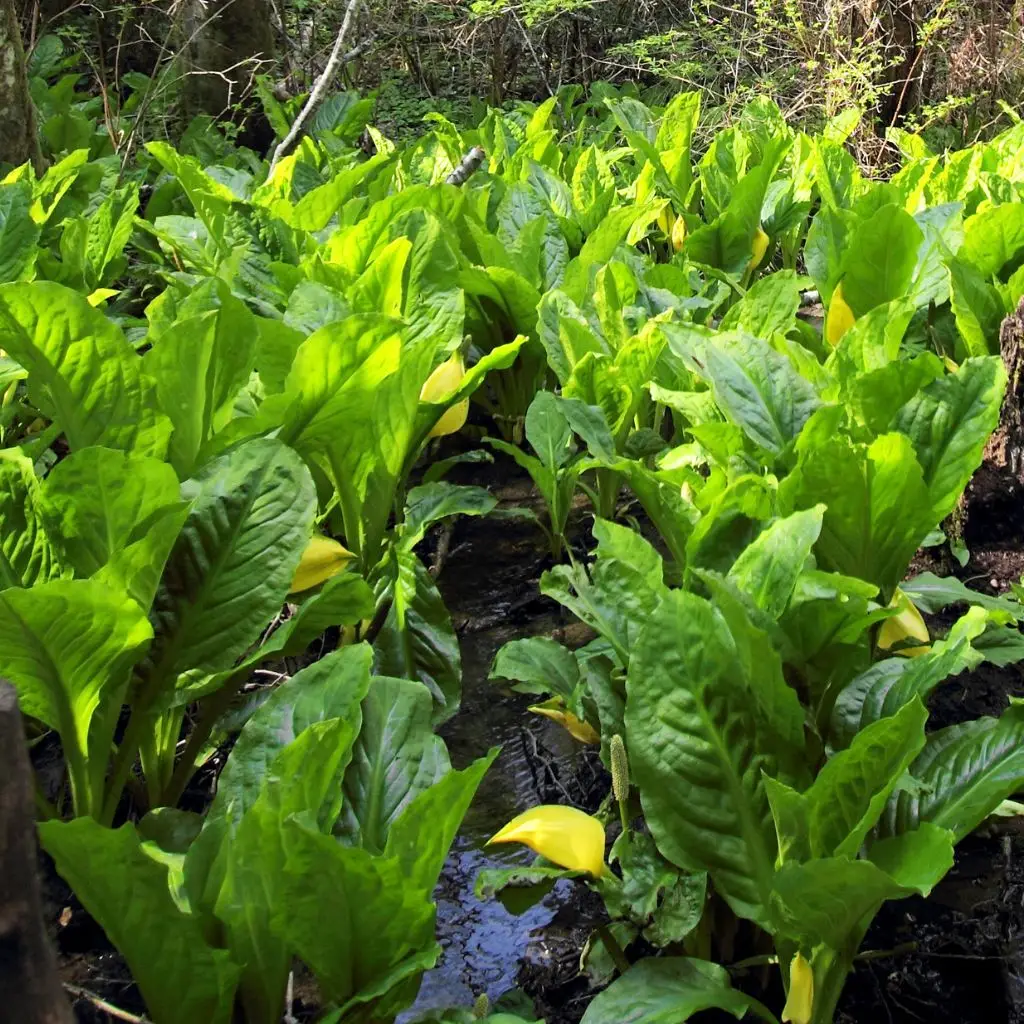
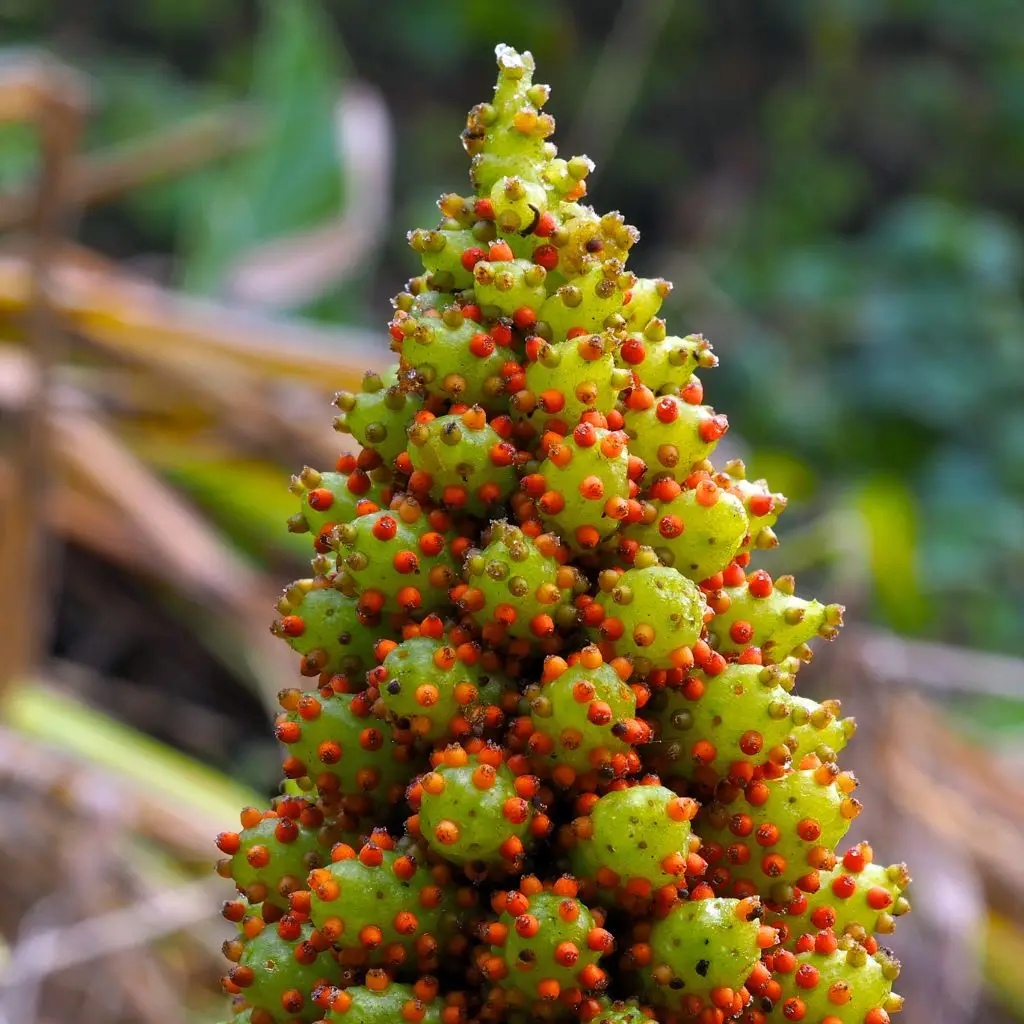
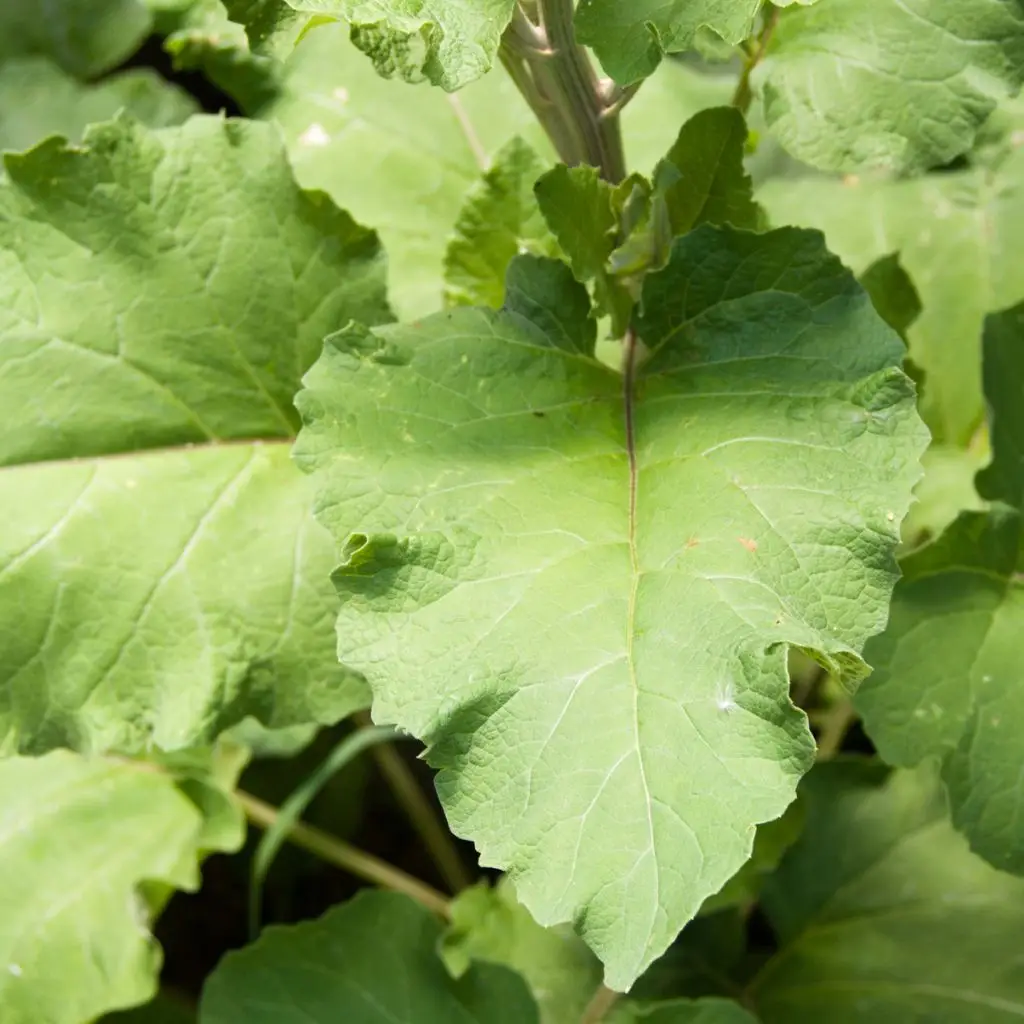
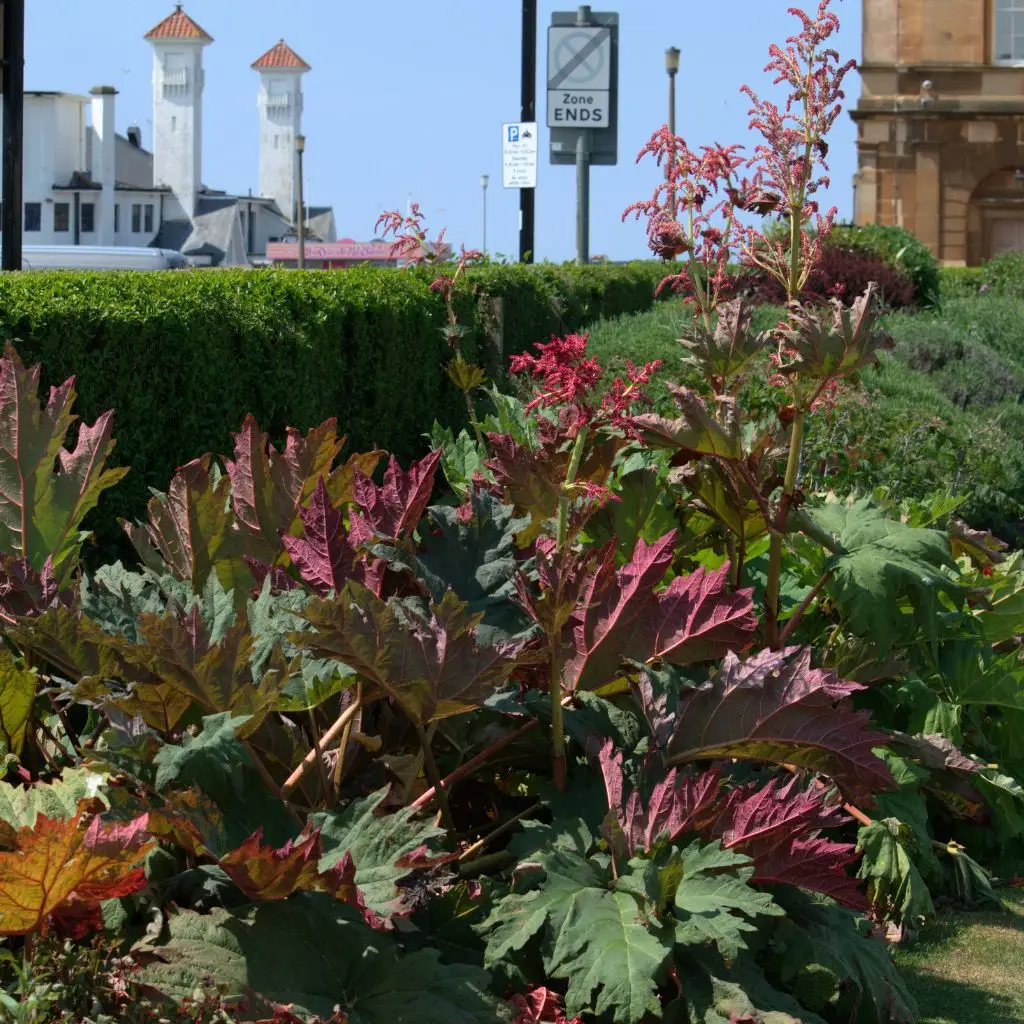
Gunnera look-alikes
While Gunnera or giant rhubarb is fairly distinctive, there are a few plants that are confused for it. Commonly mistaken plants for gunnera include:
- Common rhubarb (Rheum rhabarbarum)
Rhubarb is often mistaken for Gunnera, but there are key differences. Fisrtly, common rhubarb is much smaller, the leaves and more rounded and the stems do not have spikes. Unlike gunnera, rhubarb stems are edible when cooked.
- Burdock (Arctium Asteraceae)
Burdock is often mistaken for giant rhubarb (it’s called wild rhubarb in some places) as it can grow up to about a couple of 2 metres in height. It has less ragged leaves and it does not produce flowers but prickly burrs or thistles. Chinese rhubarb (Rheum palmatum) A clump-forming perennial, this ornamental rhubarb has larged, lobed leaves just like Gunnera. It can grow up to 2.5m tall, with impressive flower spikes, so it’s easy to see why you might mistake it for gunnera.
- American Skunk Cabbage (Lysichiton Americanus)
This is a colourful plant and can be mistaken for Gunnera primarily because it grows around waterways and is also classed as an invasive species by the Government. There are big differences in how they look, however, and the stems are generally green, the leaves a lot narrower and thicker and it produces bright yellow flowers.
Start fixing your invasive plant problem today by requesting a survey
Request a survey
Rest assured, where invasive species are identified at an early stage and tackled correctly, problems can usually be avoided. Our specialist consultants complete thorough surveys to identify the extent of the problem. Our plans aren’t one-size-fits-all; they’re customised to tackle the invasive species at your property effectively, taking account of all of your requirements.
What our clients say
Reviews
Ali Hamaad
“I used Environet following a recommendation to help with invasive Japanese Knotweed in my garden. Very professional, responsive and managed to co-ordinate with other contractors working on my property to remove the knotweed.”
Bernadette Spencer
“Richard was able to book us an assessment visit very quickly regarding the encroachment of evasive running bamboo in our garden .. Will completed the assessment visit,we found him to be very professional, but also friendly and easy to talk to. “
Phil Smith
“This is a very professional operation; always just on the end of the phone. The whole team seemed to know exactly what was going on with the job. (and my neighbours were very happy too.)”
L Schjolden
“I would like to commend your man Ed, who was in charge of the works at our property. He was a pleasure to deal with — punctual, polite, professional, responsible. He always kept me up to date with the progress of the works and made sure there was as little disruption to our lives as possible.”
GET IN TOUCH
Contact us
Our team of experts is available between 9am and 5:30pm, Monday to Friday to answer your enquiries and advise you on the next steps
Want a survey?
If you already know you have an invasive plant problem, you can request a survey online in less than two minutes by providing a few brief details. A member of the team will swiftly come back to you with further information and our availability.
Need quick plant identification?
Simply upload a few images of your problem plant to our identification form and one of our invasive plant experts will take a look and let you know, free of charge what you are dealing with. We’ll also be there to help with next steps where necessary.



